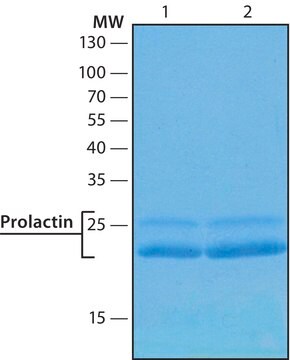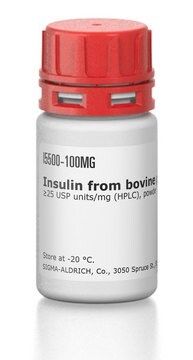L4021
Prolaktin human
recombinant, expressed in E. coli, lyophilized powder, BioReagent, suitable for cell culture, >97% (SDS-PAGE)
Synonym(e):
hPRL, LTH, Lactogenic Hormone, Luteotropic Hormone, PRL
About This Item
Empfohlene Produkte
Rekombinant
expressed in E. coli
Qualitätsniveau
Beschreibung
200 amino acid residue methionyl form of mature, recombinant human prolactin (amino acid residues 29-227).
Produktlinie
BioReagent
Assay
>97% (SDS-PAGE)
Form
lyophilized powder
Wirksamkeit
0.030-0.300 ng/mL EC50
Mol-Gew.
predicted mol wt ~24 kDa
Methode(n)
cell culture | mammalian: suitable
Verunreinigungen
endotoxin, tested
Löslichkeit
water: 0.5000 mL, clear, colorless
UniProt-Hinterlegungsnummer
Versandbedingung
ambient
Lagertemp.
−20°C
Angaben zum Gen
human ... PRL(5617)
Verwandte Kategorien
Anwendung
Biochem./physiol. Wirkung
Sonstige Hinweise
Physikalische Form
Rekonstituierung
Hinweis zur Analyse
Signalwort
Danger
H-Sätze
P-Sätze
Gefahreneinstufungen
Repr. 1B
Lagerklassenschlüssel
6.1C - Combustible, acute toxic Cat.3 / toxic compounds or compounds which causing chronic effects
WGK
WGK 3
Flammpunkt (°F)
Not applicable
Flammpunkt (°C)
Not applicable
Analysenzertifikate (COA)
Suchen Sie nach Analysenzertifikate (COA), indem Sie die Lot-/Chargennummer des Produkts eingeben. Lot- und Chargennummern sind auf dem Produktetikett hinter den Wörtern ‘Lot’ oder ‘Batch’ (Lot oder Charge) zu finden.
Besitzen Sie dieses Produkt bereits?
In der Dokumentenbibliothek finden Sie die Dokumentation zu den Produkten, die Sie kürzlich erworben haben.
Kunden haben sich ebenfalls angesehen
Unser Team von Wissenschaftlern verfügt über Erfahrung in allen Forschungsbereichen einschließlich Life Science, Materialwissenschaften, chemischer Synthese, Chromatographie, Analytik und vielen mehr..
Setzen Sie sich mit dem technischen Dienst in Verbindung.






